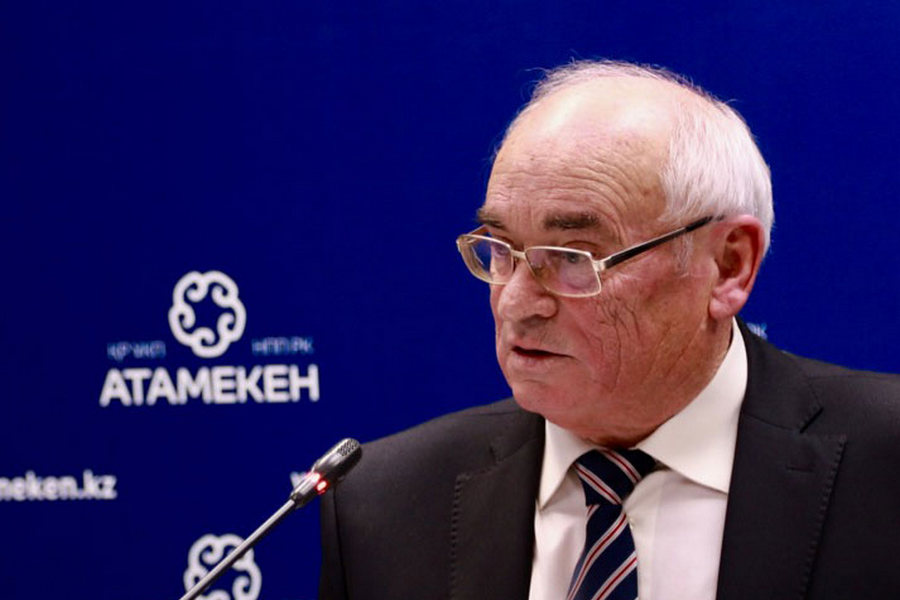EBRD Chief Economist, Beata JAVORCIK:
COUNTRIES TRYING TO BE FRIENDLY WITH EVERYONE CAN BENEFIT AND BECOME MORE ATTRACTIVE FOR INVESTMENT

As the global economy is slowing down and protectionism tendencies are rising, Kazakhstan is demonstrating steady growth – EBRD expects the country’s GDP to increase by 5.2% in 2025 and by 4.5% in 2026. Key drivers include rising real incomes, the government’s investments and development of the non-oil sector. In an interview with Interfax-Kazakhstan, Beata JAVORCIK, Chief Economist of the European Bank for Reconstruction and Development (EBRD), explained why Central Asia is currently outpacing other regions in growth, how global investment flows are shifting, and what steps Kazakhstan needs to take to attract more projects.
- Ms. Javorcik, in March the EBRD adjusted its GDP growth forecast for Kazakhstan. Can you please explain why?
- Let me start with the global context. If we take historical standards, we see a slowdown in global growth dynamics and high uncertainty amid increasingly protectionist policies.
Weak economic growth in developed Europe, which we have observed in the past two years, has led to a decrease in demand for exports from many neighboring countries. This applies to Central and Eastern Europe, some countries in the Caucasus, North Africa and the Western Balkans. However, compared to the situation in these regions, Central Asia is performing very well. The expected growth in Central Asia is 5.7%. Last year, the growth estimate for the economies of Central Asia was twice as high as for the rest of the region where our bank operates.
Overall, we are seeing that growth in all of our regions is more dependent on domestic factors. The main sources of growth were the increase in real wages, stimulating private consumption, public investment, and in some countries, remittances from workers abroad and tourism. These factors have contributed to growth in many countries, rather than external export markets.
Speaking about Kazakhstan, this year we expect growth at 5.2%, next year – 4.5%. This is similar to what many analysts predict for China. Last year showed that Kazakhstan’s growth was driven by the non-oil sector. Unemployment reached historic lows, and real wage growth was one of the drivers of the economy, helping to boost consumption. In our report, we note that in Central Asia and the Caucasus, real wages are growing faster than they were before the COVID-19 pandemic.
- The government's target indicator for 2025 is 7%, the forecast is 5.6%. Do you think the indicator will be achieved?
- We have revised our estimate of last year's results upward by 0.5%, and the base effect has led to our forecast for this year being slightly lower than in September. We expect the oil sector, in particular the Tengiz field expansion project, to contribute to growth this year. These are our experts' estimates of how we see the economy of Kazakhstan. Of course, at this time we cannot predict all the government measures that will affect the economy this year and next. Therefore, we include all the information available to us at the moment in our forecasts.
- How do you think trade flows will change in light of the unpredictable geopolitical agenda?
- Until recently, most analysts worried about the fragmentation of the global economy, that is, the division of the world into two competing trading blocs and a number of non-aligned countries. However, with the change in US government policy, the situation has changed, and it is now more correct to talk about the reconfiguration of trade flows, rather than the split of the world into two blocs.
And some elements of this reconfiguration are already visible in FDI flows. In our report, we looked at FDI in Greenfield projects, where manufacturing facilities are created from scratch. This is not a complete picture of all FDI flows, since the analysis focuses mainly on large projects, but it gives a good idea of the current trends. We have seen a sharp decline in the number of projects in China and an increase in their number in India, largely due to a change in the direction of FDI flows from the US and the West.
We have also seen an increase in FDI flows to the US and a decline in projects in Germany last year, reflecting the weakness of the German economy. What is more interesting from your perspective is the increase in projects in countries that are pursuing a multi-vector geopolitical strategy. Among them are the UAE, Saudi Arabia, Egypt, Kazakhstan and Uzbekistan.
What is interesting about the FDI flows to the countries I mentioned – Saudi Arabia, Egypt, the United Arab Emirates, Kazakhstan and Uzbekistan – is that they are coming from all directions. They are coming from Western countries, the US, China, and also from the Middle East. In other words, countries that are trying to be friendly with everyone can benefit and become more attractive for investment, because they are not involved in the tensions that we are seeing.
And, as you know, attracting FDI plays an important role in Kazakhstan’s efforts to diversify its economic activity and the structure of its economy. FDI is not only capital, but also technology, knowledge, and access to foreign markets.
- How can Kazakhstan take advantage of this friendly foreign policy?
- The trend for Kazakhstan is positive, but the number of projects attracted by Kazakhstan is still small compared to the United Arab Emirates or Saudi Arabia. Kazakhstan has less than 100 projects, while the UAE has more than 1,000 and Saudi Arabia more than 300. Kazakhstan can do more to become more attractive to investors.
Some positive changes have already occurred. If you look at the volume of investments, most of them were directed to extractive industries such as mining. But if you look at the number of projects, the positive thing is that many of them are not related to the mining industry. They were focused on transport and logistics, renewable energy, consumer goods, food and beverages, and financial services. So the structure of investments has become more diverse. However, to attract more investment, Kazakhstan needs to improve its business climate, improve its rankings in international business rankings, and benefit from having a world-class investment agency.
There is much discussion about what the new US trade policy will mean for other countries. We believe that the impact of such a tariff on the EBRD’s countries of operations – Central Europe, Eastern Europe, Central Asia and North Africa – will be limited, as few of these countries export significant volumes of goods to the US. Slovakia and Hungary, both of whom export cars and car parts to the US, and Jordan, which exports garments, are exceptions in this respect.
We also consider how the withdrawal of US foreign aid might affect the countries in which we operate. This has implications for countries such as Ukraine, Jordan, Lebanon, Moldova and Mongolia. So this is another channel through which changes in US policy affect the economic situation in other parts of the world.
- What about Kazakhstan?
A very small share of Kazakhstan’s exports is directed to the US. These exports constitute a small share of the GDP, so the direct impact of US tariffs will be minimal.
- Is it fair to say that the negative impact of the situation in global markets will not have a strong impact on Kazakhstan, given the set of measures taken earlier?
High uncertainty about future trade policies in the US and its trading partners and the impact of these policies on global growth and corporate earnings has encouraged investors to liquidate some financial assets and hoard cash. This volatility in the markets can lead to higher borrowing costs, particularly for emerging markets.
Kazakhstan has a low share of foreign currency-denominated government debt, and this debt has a longer maturity. Therefore, Kazakhstan will not be significantly affected in this case.
- What risks and benefits do you see for countries with transition economies in implementing industrial policy?
- Industrial policy is government intervention in the economy with the aim of changing its production structure. Popular instruments of industrial policy include subsidies, financial support for companies, individual industries or regions, tariffs, local content requirements, investments, and export promotion measures.
In the 1990s, industrial policy was viewed with great skepticism, since it did not bring the expected results in many countries. For example, in Latin America, import substitution policies were used - high tariffs and attempts to develop their own industry, but this did not bring success. At the same time, industrial policy proved effective in East Asian countries. Their "economic miracle" was largely associated with this policy.
Nevertheless, in the 1990s, the prevailing opinion was that governments are not good at choosing "winners" - that is, those industries that would develop and prosper in the future. And for a long time, industrial policy remained unpopular. But now it is making a comeback. This is because countries want to use it to increase their competitiveness, accelerate the process of decarbonization and respond to similar measures taken by other countries. Today, the attitude towards industrial policy has changed dramatically - in many countries it is seen as a universal solution, as a "magic pill".
In our report, we express some scepticism about industrial policy. Yes, it can work, but it is extremely difficult to implement it correctly. Often, such programs have too many goals at once: on the one hand, you want to electrify transport and increase the number of electric cars on the road, and on the other, you want to preserve jobs in the car industry. These two goals directly conflict with each other because tariffs introduced to protect employment in the car industry lead to higher prices of electric cars and hence lower sales.
Sometimes governments are too generous in their support - they overpay compared to the number of jobs these measures create or the real benefits they bring. In addition, support for one industry can hurt other industries. For example, protecting steel production from imports, will make steel more expensive for those sectors that use steel as a raw material.
For industrial policy to really work, it is important to proceed from long-term goals. It should be seen as a tool for deep structural changes in the economy, and not as a temporary aid to an industry that is currently experiencing difficulties.
It is also extremely important to preserve competition. For example, in China, electric car companies receive subsidies, but they also compete with each other. It is this competition that motivates them to create better products and achieve better results.
In addition, when implementing industrial policy, it is imperative to set clear deadlines for its implementation. Such measures cost money, and once you start giving preferences to a specific company, industry or region, it becomes increasingly difficult to stop this support. When you set an end date for industrial policy from the very beginning, it is much easier to end it - both politically and financially.
- What about Kazakhstan?
- Many resource-rich countries are looking to diversify their economies. This is no easy task. Especially since it is increasingly difficult to achieve growth based on manufacturing and goods exports due to high competition in global markets, especially from China, as well as growing protectionism which restricts access to foreign markets.
Therefore, when developing a diversification strategy, it is important to carefully analyze which sectors a country can really succeed in. In the case of Kazakhstan, the government sees agriculture as a promising area for growth. In addition, there is significant potential in the services sector.
In our report, we show that many post-communist countries have achieved great success in the export of computer services. This has been facilitated by the presence of a large skilled labor force. Countries such as Ukraine, Serbia, and the Central European states have significant volumes of computer services exports relative to GDP. The Central Asian countries, including Kazakhstan, also have a strong educational foundation, and this gives them the potential to develop in a similar direction. The sphere of computer and other professional services is one of the areas in which the region can actively develop.
- How realistic is it to implement this in Kazakhstan?
- I think it makes sense to use several strategies at once, but the diversification strategy has common key elements. One of them is the so-called horizontal policy: improving the business climate, developing institutions, reducing corruption, enhancing predictability and stability of legislation. These are measures that will benefit any country. If you look at international rankings on business conditions, Kazakhstan has the potential to improve its position.
In our report, we also touch on the topic of special economic zones. It is often impossible to immediately improve the situation in the entire country, and then the focus is on creating a favorable environment in individual locations.
The example of the Astana International Financial Center shows that such zones can be developed not only for industry, but also for the service sector. In other words, it is possible to create special economic zones focused on services, with more transparent and predictable conditions, tax incentives that will attract investment specifically in the service sector.
Many countries of the post-communist bloc have demonstrated significant economic growth due to the influx of foreign direct investment. Therefore, conducting a conscious strategy to attract foreign investors is one of the ways to create competitive advantages in new industries. This requires a world-class investment strategy that actively promotes Kazakhstan as an attractive place to do business in specific sectors. It is important to clearly define which industries you want to develop with the help of foreign investment and focus on them.
An investment agency should not only "sell" the country to investors, but also reduce information barriers. It should provide data on available locations, salary levels, and possible local partners. Its task is also to help investors navigate administrative procedures, simplify processes and thereby really facilitate decision-making about investing in the country.
- How does the EBRD assess the effectiveness of special economic zones in reducing regional inequality in Kazakhstan?
- Special economic zones - like industrial policy in general - can be used to achieve different goals. If your goal is to develop regions or reduce inequality between them, then it is logical to place the zone in a remote and less developed region. If you want to stimulate the development of new economic activity, then it is better to place the zone closer to business centers - near large cities.
We analyzed where companies engaged in export are located in Hungary. The picture turned out to be quite indicative: manufacturing exporting companies are located throughout the country - both in cities and in rural areas. But companies exporting services are concentrated in cities. Because the export of services is essentially the export of the activities of educated specialists, and such people, as a rule, are concentrated in cities.
Therefore, if the goal is to develop the export of services, then the special economic zone should be located near those who have the necessary knowledge and skills. And this means - in the city.
Is it possible to predict which special economic zones will contribute to faster economic growth in their region compared to the country as a whole? Key factors here are access to human resources with higher education and proximity to ports. That is, the presence of transport infrastructure, especially ports, is critical for zones focused on industrial production and exports.
At the same time, the quality of management is of great importance - how this zone is organized and how it is managed. The success of a special economic zone directly depends on how effectively it is administered.
- How does the EBRD plan, and does it plan, to support countries in developing and implementing effective industrial policies?
- You could say that most of the EBRD's activities are, in essence, industrial policy. Our support for renewable energy production is a way to change the production structure of the economy, to increase its competitiveness through access to cheap energy.
Our support for small and medium-sized businesses can also be seen as an element of industrial policy. The main difference in our approach is that we do not simply provide financing - we complement it with training, advice and expert support.
Small businesses around the world face similar problems: limited access to finance, lack of collateral, lack of skills. Therefore, we help entrepreneurs overcome these barriers by combining access to working capital with educational programs. To date, we have supported more than 7,500 entrepreneurs - many of them women, many young people and those who work outside Astana and Almaty.
Last year was a record year for the EBRD in terms of investment in Kazakhstan, with more than €900 million invested. Our projects cover a wide range of areas: from supporting the construction of a 600 km high-voltage power line connecting western Kazakhstan with the rest of the country, to financing a modern hospital in Kokshetau. And also the construction of a wastewater treatment plant in Aktobe. So our work combines several goals: promoting the structural transformation of the economy, eliminating regional imbalances and increasing its competitiveness.
- Thank you for your time!
May, 2025
© 2025 Interfax-Kazakhstan news agency
Copying and use of these materials without reference to the source is prohibited
Archive




